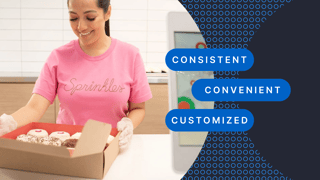
Treat brands are a unique subset of restaurants. Starting with the obvious: they don’t serve a traditional meal with protein, side, and drink. They sell donuts, cakes, smoothies, cookies, ice cream, etc.
They also have vastly different price points, target audiences, store layouts, inventory, staff training, packaging needs, marketing, and growth strategies than typical restaurants.
While every business has a unique recipe for success, leading treat brands like Sprinkles, Krispy Kreme, Great American Cookies, and Jeni’s Splendid Ice Creams, share a few important traits.
Keep scrolling to find out how some of the biggest names in the game increase awareness, sales, and long-term loyalty—and how your brand can follow suit.
1. They take branding seriously
Top treat brands know recognizable branding drives awareness and demand. As a result, they ensure every guest touchpoint—website, app, advertising, social channels, storefront, and beyond—features consistent branding.
Why?: More often than not guests are taking treats to go. You can think of your product as a moving billboard exposing new people to your brand as your guests travel around town.
Treat brands create a strong, consistent brand identity to build awareness, trust, and FOMO. This is especially important online, where purchase decisions are heavily influenced by one’s social circle.
2. They invest in high-quality packaging
They know high-quality, branded packaging is crucial for ensuring grab-and-go items travel well and look picture-perfect for social media—and invest accordingly.
Why?: Temperature control is a key consideration for treat brands. What good is frozen yogurt or a smoothie if it melts as soon as it leaves the kitchen? The right packaging will ensure your product maintains its proper temperature, presentation, and quality.
Treat brands also recognize that younger generations—especially Gen Z—love to eat, photograph, and tell their friends about their favorite sweet treats, especially on social media. As a result, they do everything in their power to ensure their brand and products are share-worthy on TikTok and Instagram. A good litmus test: Does your trademark cup/bowl/wrapper/bag stand out in a sea of images or videos?
3. They prioritize frictionless ordering
Treat brands make ordering as easy as pie. That guest-centric approach is evident in everything from their user-friendly menu and same-day or order-ahead capabilities, to self-service options like kiosks. The goal is to ensure guests can easily order how, when, and where they want.
Why?: While leisurely meals are pretty standard for traditional restaurants, sweet treats are typically a fast transaction. Whether guests stop by on their way to work, while wandering around the mall, or after dinner, they usually aim to quickly get in and out of the store or drive-thru.
4. They encourage customization
These brands don’t just enable order customization, they encourage guests to mix and match to their hearts’ content. For example, shaved ice brand Bahama Bucks figured out how to showcase 100+ flavors and modifiers with mouth-watering imagery without overwhelming guests.
Why?: A treat is a splurge and a source of delight. People go out of their way for something sweet, as part of a celebration, or just because. So everything about the guest experience must feel extra special—including the ability to dream up your perfect combination of flavors and toppings.
5. They let guests dine how they want
Leading treat brands offer multiple ways for guests to receive their orders—including delivery, drive-thru, dine-in, curbside, and in-store pickup. In doing so, they demonstrate they value guests’ time and understand people have different needs and schedules.
Why?: When it comes to sweet treats, guests bank on convenient, fast service and freedom of choice. And the happier you make your guests, the more likely they will return and tell their friends.
6. They provide multiple payment options
They offer a seamless checkout experience with multiple payment options, such as digital wallet support, the option to save a credit card on file, and the power to log in and check out without a password.
Why?: Thanks to e-commerce giants like Amazon and Shop Pay, consumers have become accustomed to securely speeding through checkout. And, if you’re hankering for a cookie or a sugary pretzel, the last thing you want to worry about is recalling a password or manually entering payment information.
If you make the checkout experience easy for guests the first time, they’ll be more likely to make their sweet treat a habit.
7. They consolidate orders in one place
They use one dashboard to consolidate orders. This enables them to meet quests where they are—on Google, third-party marketplaces, social media, etc.—and stay on top of orders without juggling tablets.
Why?: Treat shops are typically limited on physical space and staff. You’re in big trouble if you’ve got orders flying in from multiple channels at once and only two people on duty.
A single dashboard enables your team members to manage and control all digital orders—regardless of origin—while reducing training, manual POS entry, and human error.
8. They offer catering
Treat brands recognize the value of catering for overall revenue and that every event—big or small—could benefit from something sweet. To meet guests' unique needs, they create flexible catering packages for holidays, weddings, business meetings, and everything in between.
Why?: Catering has the potential to represent up to 20% of a restaurant’s total revenue. By capitalizing on the catering boom, treat brands can diversify their revenue streams, attract new guests, bolster their reputation, and become a memorable part of celebrations year-round.
9. They personalize marketing campaigns
To ensure guests return often, they tailor marketing campaigns to individual preferences and behavior and create incentives using a loyalty program or insights from a guest data platform.
Why?: Treat brands rely on repeat orders from high-value guests because of their high-volume, low-margin menus. With 1:1 marketing, they leverage data—such as how often a guest orders donuts, how many, their favorite flavors, if they typically order in-store, etc.—to make every guest feel like a regular and drive recency, frequency, and spending.
10. They are social-media savvy
They get to know their target market intimately, including likes, dislikes, behavior, and preferred communication style, and use that intel to fuel their social media content strategy.
Why?: There’s only one thing younger generations love more than sweets and it’s social media. Treat brands leverage platforms like TikTok and Instagram to reach Millennials and Gen Z, foster community, and drive sales by jumping on trends, sharing user-generated content, tapping relevant influencers, and showing off their personality.
11. They promote their direct ordering channels
Leading treat brands heavily promote their website and app to encourage guests to order directly. In addition to marketing, they optimize their website and app for conversion, place direct ordering links across platforms, leverage the Order with Google enhanced redirect, implement on-premise digital ordering, and educate guests and staff about the benefits.
Why?: Direct ordering lessens a treat brand’s reliance on third-party marketplaces. (Smaller check sizes and high commission fees don’t mesh well.) It also ensures the brand maintains ownership of its guest relationship and data, which are key to retention efforts.
How they do it—and how your brand can, too
Any successful treat brand will tell you that in order to drive profitable traffic and scale your business, you need a tech stack that can keep up.
With an enterprise-grade digital ordering platform designed to support multiple sales channels—featuring capacity management and machine-learning tools—you can streamline operations and create the convenient, frictionless experience your guests crave.
Combine that with a fully integrated payment system and guest data and engagement solutions, and you’ve got a flywheel to accelerate business growth.
Request a demo to see why leading treat brands use Olo’s platform—a mission-critical source of guest data—to increase orders, streamline operations, and improve the guest experience.


